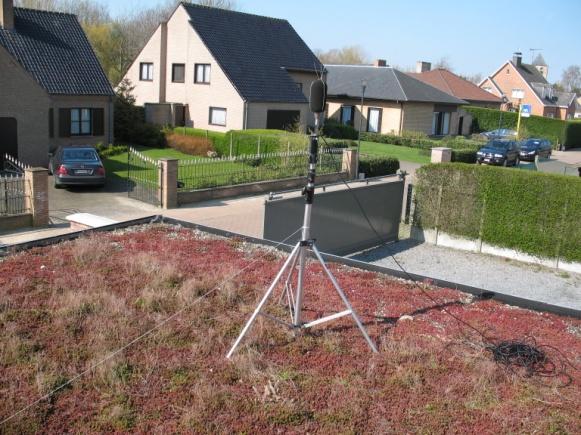


Green Roofs for Quietness
Dr. ir. Timothy Van Renterghem
Popular version of paper 4aNSc7
"Green roofs to enhance quiet sides"
Vegetated roof tops (green roofs) thank their increasing popularity to a large number of ecological and economic advantages. Green roofs considerably increase the thermal insulation of the roof system, leading to lower energy costs, both in hot and cold climates. Green roofs may also temporarily store a large amount of water, reducing the runoff peak of rainfall events. In this way, flooding risks might be reduced in urban areas, consisting mainly of impervious surfaces. Green roofs help to improve air quality as well by filtering airborne particles from the air, by an increased carbon dioxide uptake, and by reducing traffic related ozone production in cities. It is further known that green roofs protect the roof membrane, increasing its life time. Other evident advantages are an improved biodiversity in urbanized areas, and the creation of a more pleasant visual environment for citizens.

Green roofs also reduce noise
Green roofs have important acoustical benefits as well. Green roofs have a higher weight resulting in an increased sound insulation of the roof system. This could lead, depending of the geometry of the building, to strong reductions of indoor noise levels during e.g. a plane fly-over.
We discovered that green roofs can also be used to successfully reduce road traffic noise exposure, which is the main source of noise annoyance in urban areas. Diffracting waves may reach the backside of a building or a roof apartment (penthouse) after shearing over the roof. Despite the shielding caused by the building, noise levels may still be unacceptable large at these locations. The typical substrates used for green roofs are (highly) porous and thus allow sound waves to enter the growing mediums. Because of the large number of interactions between sound waves and substrate particles, attenuation occurs. As a result, less noise will reach the back façade or the roof apartment compared to the situation with a non-vegetated roof that is most often made of a highly reflective material (e.g. concrete).
Extensive and intensive green roofs
There are two main types of green roofs. Extensive green roofs only need a thin layer of soil substitute, which is usually a granular material. They support low-growing plants like Sedum species and grasses. Intensive green roofs, on the other hand, require larger soil depths, and may allow growing shrubs or even trees. The substrate is normal earth, just like in ordinary gardens. While extensive green roofs can be placed on most existing roofs, intensive green roofs need a special roof construction because of their heavy weight.
What reductions can be expected? What parameters are important? A numerical study!
Simulations are an interesting tool to quickly identify relevant parameters, and help to optimize green roofs for noise reduction. A detailed numerical model was developed to predict the reduction that can be achieved by replacing a classical rigid roof with a green roof. For modeling sound propagation inside the typical substrate layer, dedicated equations were introduced in the model.
Numerical results show that with increasing sound frequency, the attenuation by a green roof increases strongly. Low frequencies have large wavelengths that are incapable of entering sufficiently the growing medium, and consequently no attenuation occurs. For the octave band of 1000 Hz, on the other hand, an increase in shielding up to 10 dB was found by the presence of an extensive flat green roof (covering 80 % of the roof surface), compared to exactly the same building geometry with a fully rigid flat roof (see figure). A good reduction of the noise level at the 1000 Hz octave band is essential, since it has the main contribution in a typical road traffic noise spectrum.
Substrate layer thickness was found to be an important design parameter. At the 1000 Hz octave band, the optimal value is near 10 cm. With decreasing frequency, as depicted in the figure, this optimum is less pronounced and shifts towards thicker substrates. Note however that extensive green roofs usually fall in the range from 5 cm to 20 cm in practical applications. Road traffic noise reduction at shielded building façades is therefore an important application of extensive green roofs.
The percentage of the roof covered by green largely determines the improvements that can be obtained. The predicted attenuation, relative to a rigid roof, increases linearly with the green roof fraction. This means e.g. that a tilted green roof leads to a larger (relative) improvement in shielding than a flat green roof, since there is more interaction between sound waves and the substrate.
Conclusions
It was concluded based on the numerical analysis that both extensive and intensive green roofs have the potential to reduce sound pressure levels at shielded places. Replacing a rigid roof by an optimized green roof, in case of a saddle-backed roof, improves shielding from road traffic noise up to 10 dBA. For the average listener, such a reduction in sound pressure level corresponds to halving of the loudness. The findings by the numerical study are confirmed by preliminary measurements near green-roofed buildings.